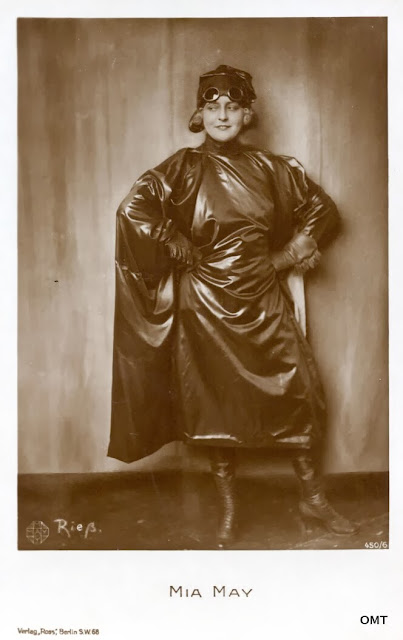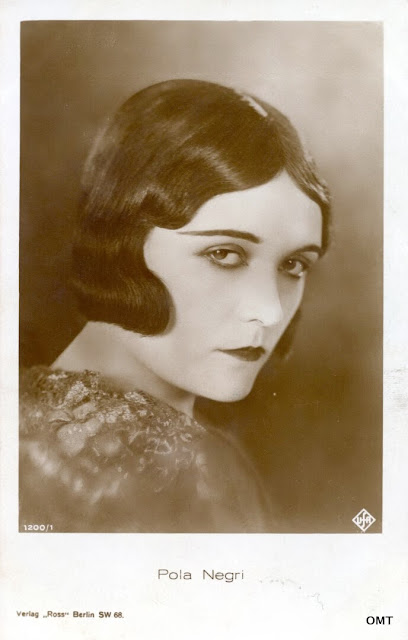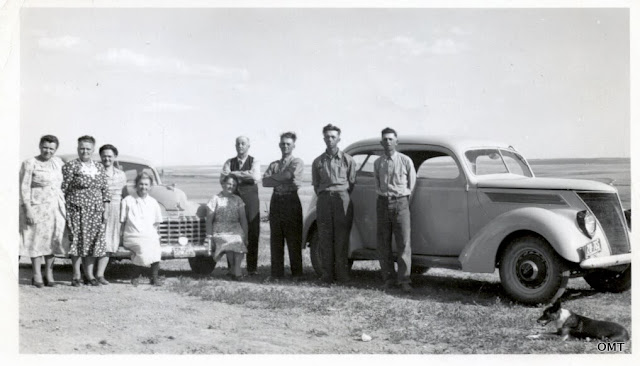Three German Silent
Film Actresses and their fates
“What is fame?
The advantage of being known by people of whom you yourself know nothing, and
for whom you care as little.”
Lord Byron
Fern Andra was born in Watseka, Illinois in 1893. Unless you
live in Watseka, most likely you have never heard of it, being one of those
small towns on the Midwest plains that get no attention from anyone except
comedians. Her career as a performer began when she was four years old, walking
the tightrope in a travelling circus. Go forward twenty years and she has moved
to Berlin, about as existentially remote from Watseka as Antarctica is
geographically. She is acting in films like
Homunculus and Der Frauspekulant
but more than that, a lot of the films she is appearing in she is also writing,
directing and producing. The titles mean nothing to me (Drohende Wolken am Firmament: Threatening
Clouds in the Sky) though they have a suitably sturm und drang ring to
them. So we come to this portrait, which at first glance looks like a
fashionably polite exercise in soft erotica, which any studio might turn out.
But look at the bottom right: ‘Atelier Fern Andra’. She is also running a photographic studio, and as this makes
clear, taking and controlling the distribution of her own portraits.
Her obituary in the New
York Times of February 12, 1974, states that during World War 1 she was a
spy for the Allies, was arrested but released on the orders of Kaiser Wilhelm.
The evidence may prove a little less melodramatic but the basic facts may be
accurate. Mata Hari is the best known of a number of performers who doubled as
spies.
With this skeleton of background information at hand, you’d
think that one place to look for some information about Ms Andra would be the
numerous feminist film books out there. Here is a woman who set out on her own
path during the earliest days of cinema, but: The Red Velvet Seat; women’s writings on the first fifty years of
cinema? Nothing. Weimar Cinema?
Zilch. Nordic Exposures? Likewise, nada.
Even Kevin Brownlow’s The Parade’s Gone
By, admittedly by a man and focused on Hollywood but still one of those
books anyone interested in silent film agrees is indispensible – zero. Could it
be that too many of the women who have written about early cinema from a
feminist perspective have been as vacuously middle class as the men they dismiss
for being just that? It isn’t hard to make the charge stick. There’s loads of
material and reconsiderations of some obvious names like Greta Garbo but little
on others you’d expect, who took risks and challenged the orthodoxy.
Part of the problem may be, as it so often is, bad timing.
We read that in the early 1920s Fern Andra was one of the most popular
actresses in Germany, but by mid-decade her star was waning. We also read that
in 1925, about the time these portraits were taken, she was married to Kurt
Prenzel, middleweight boxing champion of Germany, who valiantly protected her
from a dog as she stepped out from an automobile. It turns out the dog was
rabid and the press feared Herr Prenzler’s ‘stellar’ career was threatened as a
result. It wasn’t. He went on to fight such ring legends as Roxie Allen, Joe
Kubiak and Jerry Kucella (won 8, lost 23). He comes across as a man whose
lifestyle was more interesting than his sporting prowess. Maybe the Germans
thought the same of Ms Andra: wonderful to look at, difficult to watch. She
wisely dropped the first of her four husbands and went to London before
returning to America, where she had to start again. It looks like she turned up
in Hollywood around the time of the transition to sound, and like hundreds of
others discovered the rules had changed. To have her star fading on one side of
the Atlantic and barely glimmering to life on the other was bad enough, but if
both the Americans and the Germans thought of her as a foreign actor she had
little in the way of an identity to promote. The red carpet, such as it was,
was pulled out from under her feet. Perhaps, had she stayed in Germany, we
would know her now as a fearless pioneer in cinema, Instead, she is forgotten.
From what I read of Mia May, her popularity rivalled that of
Fern Andra in the early 1920s but it was of an entirely different nature. Her
husband, Joe May, pumped out dozens of short, dramatic two-reelers featuring
Mia as the plucky heroine. Mostly
they had colourful titles like Die
Silhouette des Teufels (Shadow of the
Devil) and Die Herren der Welt (Mistress of the World). The German audiences
lapped them up but, like cats at a bowl of milk, once a film was finished all
they cared about was when the next one was ready. The Mays’ best known is an
epic silent serial known as The Mysteries
of India, with a script by Fitz Lang.
Yet, when you look through enough of the postcards in the
Ross Verlag catalogue, you come away thinking that no one played up to the
publicity machine with more vigour and joie de vivre. Most of the actresses who
sat for the German photographic studios were (or allowed themselves to be)
portrayed as living in a haze of glamour and sophistication. Mia May, on the
other hand, appeared to understand she was only an actress and played that for
all it was worth. Among the thousands of film star portraits produced during
the 1920s, hers remain some of the most striking. At the bottom of all of them
is the logo with ‘May’ in a cross, framed within an octagon, a reminder that she
and her husband controlled what images Ross Verlag received.
A previous post described how their daughter, Eva May,
committed suicide in 1924 and the tragedy led to Mia May retiring from acting.
That decision made, she might have missed the life but she never returned to
it. Joe May was Jewish and around 1934 the couple left Germany for America. They
joined that group of German émigrés/refugees that included Lang, Berthold
Brecht and Billy Wilder but May’s films seldom made a big impression. In Hollywood she opened a restaurant,
the Blue Danube. Its failure preceded difficult years for the Mays. By 1948 Joe
was pawning Mia’s jewellery to make ends meet. He died in 1954, Mia May in
1980. She was long forgotten by then.
The stories of Andra and May are variations on a commonly
accepted understanding. Fame and its side benefits are constructions that have
little to do with talent. The machine of publicity has an engine operating on
principles that no one really understands. Pola Negri’s story is another type.
Celebrated in Germany before she arrived in Hollywood, little of her work in
Europe or America stands today as cinematically brilliant. Granted, ‘classic’
is applied to any film older than ten years, there’s nothing in her resumé to
suggest she played any great and memorable roles. Yet the image of Pola Negri remains vivid. Hers is a face of the silent era
as identifiable as Chaplin’s tramp. Her early life reads like the most
depressing Russian realism - born into poverty, father disappeared when she was
young, two sisters died in childhood - but the woman who sails into New York in
1922 is depicted as possessing all the exotic and decaying glamour of Eastern
European royalty.
More interesting than her filmography then is the way the
publicity machine built up around her worked. American papers were reporting
her imminent arrival even before her ship left Europe. When it docked and she
was settled in her hotel, reporters asked her about the rumoured clause in her
contract that insured Paramount for one million dollars against her marrying.
“I live only for my art.” She apparently replied, acknowledging something
everyone already took for granted. “I shall not marry for three, maybe four
years.” The statement not only implied she was keeping an eye out for suitors
but the press would too. Her repeatedly broken engagements to Charlie Chaplin
and romance with Rudolph Valentino were gifts to the newspapers.
On June 30, 1927, the New
York Times reported that Pola Negri had been bitten by a spider.
Fascinating. These days celebrities have publicists whose job is to keep their
client’s name in the media, so toss off every detail they can. In 1927 the
publicist worked for the film studio not the star. The important issue was not
that Ms Negri had been bitten by a spider but that as a result filming had been
held up for a day. It is possible that the story was fictitious and intended to
hide some deeper problem with the contract or her behaviour. Whatever the truth, the story tells us
a lot about how the studios were learning how publicity really worked. The
studio had invested too much in her to risk the audience losing interest. If
nothing was happening in her world this week then a spider bite could be
regarded as potentially life threatening.
So why did Pola Negri go on to the closest thing the cinemas
offers in the way of immortality while Fern Andra and Mia May sank? The paradox
was that by taking control of their own images, Andra and May had no recourse
when those stated to fade. Maybe because of her horrid childhood, Ms Negri
understood more keenly the value in placing her image in the hands of the
studios. It may have been a concoction but it was one she approved of and turned
out to be more enduring than one she may have devised herself.
 |
| ASTRAL PROJECTIONS |































